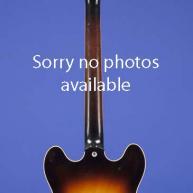A Real Piece of American History…
This 13 1/4-inch-wide semi-solid body 'featherweight' guitar weighs just 6.80 lbs. and has a nice, fat nut width of just over 1 11/16 inches and a scale length of 24 1/2 inches. Chambered mahogany body with the earliest knotty pine top with the "G" branded into the front and with studded leather tooled with Western motifs around the sides, mahogany neck, and bound rosewood fretboard with 22 frets and inlaid pearl hump-top block position markers. Headstock with inlaid pearl Gretsch "T-roof" logo and steers head inlay. Individual Grover StaTite tuners with oval metal buttons. Two single-coil DeArmond 'Dynasonic' pickups, with outputs of 3.13k, and 3.05k. The original tortoiseshell pickguard with engraved steer's head has disintegrated and is no longer present (the original bracket and retaining screw is in the case). Four controls (master tone and two individual volume controls on lower treble bout, one master volume control on cutaway bout) and one three-way selector switch on upper bass bout. Earliest version of metal knobs with cross-hatch pattern on sides and plain tops. Melita Synchro-Sonic bridge and G-hole flat tailpiece with Western-style belt buckle covering the string anchors. All hardware gold-plated. There is a small area on the back of the guitar which is a lighter shade of mahogany. Apart from the bare minimum of belt-buckle wear on the back of the body, and one small indentation on the top by the branded "G" and a few tiny surface marks, a tiny amount of body checking, this fifty-one year old piece of western history is in remarkably fine and original condition. Housed in its original Gretsch straw-colored fitted case with burgundy plush lining (8.50).
This is the first knotty pine Round Up that we have owned and in fact only the second that we have actually seen. The other one isn't for sale for any price! The knotty pine top was quickly replaced in 1955 by a solid mahogany body...but everybody wants the original knotty pine Round Up.
"A 1954 model 6130 Round Up with knotty pine top...notice there is no inlay in the first fret, a characteristic commonly found on 1954 Round Ups. The tortoiseshell plastic pickguard is beginning to crystallize and degenerate, an unfortunate condition which may have driven the company to introduce Lucite pickguards as early as 1954 on some models". (Jay Scott, The Guitars of The Fred Gretsch Company, p. 147).
"Two more extraordinary quasi-solidbodies, the Model 6130 Round Up and Model 6121 Chet Atkins Solidbody, poured out of the Golden Age, and so, by 1955 Gretsch had introduced six colorful, exotic, innovative solids to complement its own dazzling hollow-bodies and compete with Gibson's gold-finished Les paul Standard which looked drab and unimaginative by comparison. Once again, in a colorful cultural era, Gretsch had covered the competition… The $360, 1954 Model 6121 has a contoured, laminated maple top laid on its hollowed-out body while the $300 Model 6130 (the difference in price being accounted for the Atkins appointments and endorsements of the former) is topped in pine which sometimes appears with dramatic knotty figures." (Jay Scott, The Guitars of The Fred Gretsch Company, p. 123).
Aimed at the rising number of country players, Gretsch adorned the Round Up with unrelenting Western decoration. "The Round Up had a steer's head logo on the headstock and pickguard. There were various Western motifs (mostly steer's heads and cacti) engraved into the block fingerboard markers. A belt buckle with a homely wagon-train scene was attached to the tailpiece. There was even a big G (for Gretsch) actually branded into the front of the 'Western' orange-finish body, which had metal-studded leather stuck around its sides embossed with yet more cacti and steer's heads. And to hang all this from the shoulders of the adoring new owner, the guitar came with a leather strap encrusted with rhinestones and decked out the obligatory steers and cacti. Subtle it was not. Gretsch optimistically described the Round Up as having 'masculine beauty'" (Tony Bacon and Paul Day, The Gretsch Book, p. 22).
Translate:


